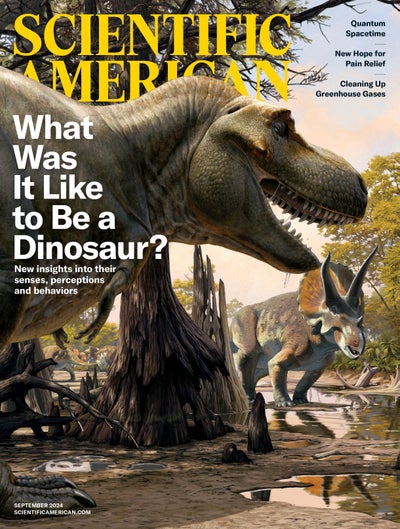New Issue: September 2024 |  | Dear Friend of Scientific American,
We have some hopeful news in our September issue about a new type of painkiller. One in five adults in the U.S. live with chronic pain, and almost everyone suffers from occasional pain. Over-the-counter drugs are often not enough, and opioids put people at risk of addiction and overdose. The new class of drug, the first one of which could be approved this year, works on the peripheral nervous system to stop pain signals from reaching the brain. We're very cautious about overstating medical advances, but everyone our writer spoke with is optimistic about this new approach to pain management.
Our cover story in this issue asks What Was It Like to Be a Dinosaur? And answers that question with some surprisingly sophisticated insights into their behaviors and sensations. Our expert authors, an evolutionary biologist and paleontologist, explain what they've learned from merging neuroscience studies of living animals' brains with lots of analyses of dinosaur skulls. The illustration, by a paleoartist who also creates museum displays, made some of us in the office go "grawr!"
Capturing carbon dioxide in the air and storing it someplace harmless could potentially help slow global warming. Governments and private industry are investing billions, and the sector is suddenly growing very quickly. We explain how it works, why fossil fuel companies are so interested, and what technologies are being developed (the graphics help a lot). This is the first in a series of three stories about different types of carbon capture, with the next one coming in a few months.
The physicists seeking an explanation for dark matter are getting concerned. They thought they would have found it by now. This mysterious stuff exerts gravitational pull on everything we observe, but is not itself observable. When it was first detected, physicists came up with a lot of possible explanations and started testing them, with no success. Now some experts say we may never be able to figure out its true nature.
One reason we have new pain medications (and vaccines, cancer drugs, antivirals and more) is that lab rats and other animal models allow researchers to test new compounds. But biomedical research has advanced so much that much of it is moving beyond guinea pigs – new organoids, organs on a chip, machine learning and other technologies are replacing lab animals. Lab animals were always imperfect proxies for the human body, giving false positives (drugs that work in them don't work in humans) and false negatives (drugs that would work in humans never get developed because they fail in animal models). It's exciting to see these new techniques start to change how science is done.
Best wishes, Laura Helmuth Editor in Chief
| | | New fossils and analytical tools provide unprecedented insights into dinosaur sensory perception. | Dark matter has turned out to be more elusive than physicists had hoped. | Tech firms, oil companies and the U.S. government are investing billions of dollars in carbon capture technology to suck greenhouse gases out of the atmosphere. Can it save the warming world? | Replacing research animals with tools that better mimic human biology could improve medicine. | The medication initially known as VX-548 blocks sodium channels in nerves, blocking pain signals before they reach the brain. | Proposed experiments will search for signs that spacetime is quantum and can exist in a superposition of multiple shapes at once. | To view this email as a web page, go here.
You received this email because you opted-in to receive email from Scientific American or you have registered for an account with Scientific American.
To ensure delivery please add specialoffers@scientificamerican.com to your address book.
| | | | | | |
Comments
Post a Comment